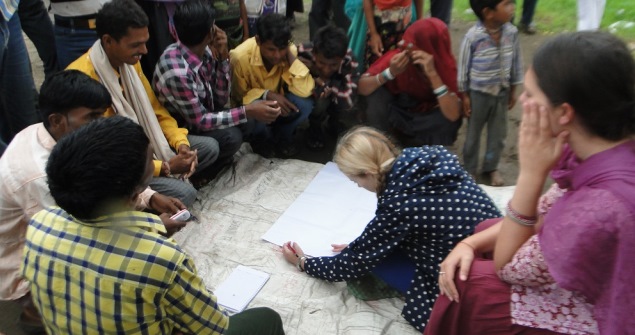Sampark Madhya Pradesh
Research on Digital Divide
 Data Collection for research on digital divide in progress
Data Collection for research on digital divide in progress
Information and communication are two important components of development practice as without effective communication to transfer information to the deprived sections it will not be possible for them to take advantage of various government programmes and also compete in the market. Sampark conducted a research in Jhabua district as part of a larger survey spread across five districts of Madhya Pradesh to estimate the extent of access of deprived sections to mobile telephony, internet and electronic media. The aim was to see the level of the digital divide between urban and rural areas, between the rich and the poor, between the general castes and the tribes and between men and women.
The research was conducted in the four villages of Hanumantia, Kalighati, Matapada and Roopgarh selected on the basis of their distance from the town of Petlawad so as to estimate the influence of geographical remoteness on digital access. The objectives of the research were as follows:
- An estimation of the reach of various digital services in the area and the level of access that the people have to these.
- An estimation of the influence of and change in the use of various digital media.
- An estimation of the rates of various digital services and their quality and the satisfaction of the users.
- On the basis of the results of the survey to conduct meetings in the villages to convey the importance of digital media as conveyors of information and means of grievance redressal and the need for eliminating the digital divide.
- Correlate the digital divide estimates with the human development indices to see if there is a relationship between the two.
The study firmly established that there exists a significant digital divide which is negatively impacting on the rights of the deprived sections to equitable and sustainable development. Differences exist in access to the different media along caste lines. While the General Castes have 100 per cent access to mobile telephony, the Other Backward Classes (OBC) have 95 per cent, Scheduled Castes (SC) have 67 per cent and the Scheduled Tribes (ST) have the least at 60 per cent. In the case of access to television the difference is even more stark with the General Castes having 100 per cent, Other Backward Classes 89 per cent, Scheduled Castes 33 per cent and Scheduled Tribes 17 per cent. The biggest divide as is to be expected was found in access to internet with once again the General Castes having 100 per cent, the Other Backward Classes 37 per cent, Scheduled Castes 1 per cent and Scheduled Tribes 6 per cent.
The survey showed that the access levels varied inversely with the distance from Petlawad and with income levels. There is also gender inequality in access to digital media with only 34 per cent women having mobile phones, 2 per cent having control over the television remote and 12 per cent having access to the internet. With regard to mobile services the main obstacles to access were the high cost and lack of language proficiency. With regard to the internet the main obstacles to access were the lack of infrastructure and language proficiency. Meetings were conducted in the villages to discuss the adverse impact of this huge digital divide that exists in the project area. Given that mobile telephony and the internet are increasingly going to become the media for conveying information and registering grievances, the importance of removing the digital divide with respect to these two media was driven home in the discussions.


